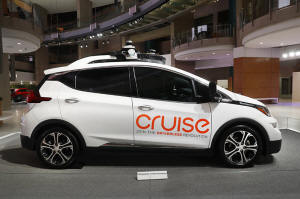GM to retreat from robotaxis and stop funding its Cruise autonomous
vehicle unit
 Send a link to a friend
Send a link to a friend
 [December 11, 2024] By
TOM KRISHER [December 11, 2024] By
TOM KRISHER
DETROIT (AP) — General Motors said Tuesday it will retreat from the
robotaxi business and stop funding its money-losing Cruise autonomous
vehicle unit.
Instead the Detroit automaker will focus on development of partially
automated driver-assist systems for personal vehicles like its Super
Cruise, which allows drivers to take their hands off the steering wheel.
GM said it would get out of robotaxis “given the considerable time and
resources that would be needed to scale the business, along with an
increasingly competitive robotaxi market.”
The company said it will combine Cruise's technical team with its own to
work on advanced systems to assist drivers.
GM bought control of San Francisco-based Cruise automation in 2016 with
high hopes of developing a profitable fleet of robotaxis.
Over the years GM invested billions in the subsidiary and eventually
bought 90% of the company from investors, all while racking up millions
in losses.
GM’s brushoff of Cruise represents a dramatic about-face from years of
full-blown support that left a huge financial dent in the automaker. The
company invested $2.4 billion in Cruise only to sustain years of
uninterrupted losses, with little in return. Since GM bought a
controlling stake in Cruise for $581 million in 2016, the robotaxi
service piled up more than $10 billion in operating losses while
bringing in less than $500 million in revenue, according to GM
shareholder reports filed with the Securities and Exchange Commission.
The automaker even announced plans for Cruise to generate $1 billion in
annual revenue by 2025, but it scaled back spending on the company after
one of its autonomous Chevrolet Bolts dragged a San Francisco pedestrian
who was hit by another vehicle in 2023.

The California Public Utilities Commission alleged Cruise then covered
up details of the crash for more than two weeks.
The embarrassing incident resulted in Cruise’s license to operate its
driverless fleet in California being suspended by regulators and
triggered a purge of its leadership — in addition to layoffs that
jettisoned about a quarter of its workforce.
GM CEO Mary Barra told analysts on a conference call Tuesday the the new
unit will focus on personal vehicles and developing systems that can
drive by themselves in certain circumstances.
The company has agreements to buy another 7% of Cruise and intends to
buy the remaining shares so it owns the whole company.
The move is another step back from autonomous vehicles, which have
proved far harder to develop than companies once anticipated. Two years
ago, crosstown rival Ford Motor Co. disbanded its Argo AI autonomous
vehicle venture in Pittsburgh that it co-owned with Volkswagen.
At the time the company said it didn’t see a path to profitability for a
number of years.
[to top of second column] |

Cruise AV, General Motor's autonomous electric Bolt EV, is seen on
Jan. 16, 2019, in Detroit. (AP Photo/Paul Sancya, File)
 Yet other companies are pressing
forward with plans to deploy autonomous vehicles and expanding their
services.
Alphabet Inc.'s Waymo is accelerating plans to broaden its robotaxi
service beyond areas of metropolitan Phoenix, San Francisco and Los
Angeles. Last week the company said it would begin testing its
driverless Jaguars in Miami next year, with plans to start charging
for rides in 2026.
The move comes less than a month after Waymo opened up its robotaxi
service to anyone looking for a ride in an 80-square-mile (129
square kilometer) area of Los Angeles. Waymo also has plans to
launch fleets in Atlanta and Austin next year in partership with
ride-hailing leader Uber.
In April, a company called Aurora Innovation plans to start hauling
freight on Texas freeways using fully driverless semis.
Tesla CEO Elon Musk has said his company plans to have autonomous
Models Y and 3 running without human drivers next year. Robotaxis
without steering wheels using Tesla's “Full Self-Driving” system
would be available in 2026 starting in California and Texas, he
said.
But an investigation by the National Highway Traffic Safety
Administration into Full Self-Driving's ability to see in low
visibility conditions cast doubt on whether Teslas are ready to be
deployed without humans behind the wheel.
The agency began the investigation in October after getting reports
of four crashes involving “Full Self-Driving” when Teslas
encountered sun glare, fog and airborne dust. An Arizona pedestrian
was killed in one of the crashes.
GM said it will work with Cruise’s leadership to restructure the
company and refocus Cruise’s operations on driver assist systems.
The company expects the restructuring to reduce spending by more
than $1 billion annually.
Cruise has about 2,300 employees and will retain a presence in San
Francisco, GM said. It’s too early to talk about employment levels
until the restructuring is completed next year, a spokesman said.
Dave Richardson, senior vice president of software and services
engineering, said Cruise will bring its software, artificial
intelligence and sensor development to GM to team up on improving
GM’s driver-assist systems.
“We want to leverage what already has been done as we go forward,
and we think we can do that very effectively,” Barra said.
Shares of GM rose about 3% in trading after Tuesday's closing bell.
They are up about 47% for the year.
_____
AP Technology Writer Michael Liedtke in San Francisco contributed to
this report.
All contents © copyright 2024 Associated Press. All rights reserved |